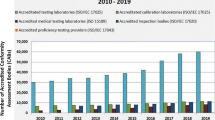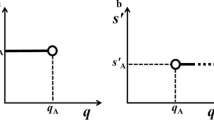Abstract
A method for the calculation of the limits of detection (LD) and quantification (LQ) for the analysis of organochlorine compounds in serum is described. The method is based on the analysis of proficiency testing materials, an external quality assessment for selected pollutants, and the study of the signal/noise ratio of chromatograms obtained from GC-ECD injection. This method provides representative results for matrix effects, instrumental variability and extraction recoveries in the analysis of serum samples.



Similar content being viewed by others
References
Grimalt JO, Sunyer J, Moreno V, Amaral OC, Sala M, Rosell A, Anto JM, Albaiges J (1994) Int J Cancer 56:200–203
Corley J (2002) In: Lee PW (ed) Handbook of residue analytical methods for agrochemicals, 1st vol. Wiley, New York
Zorn ME, Gibbons RD, Sonzogni WC (1997) Anal Chem 69:3069–3075
IUPAC, Analytical Chemistry Division (1976) Pure Appl Chem 45:99
ACS Committee on Environmental Improvement (1980) Anal Chem 52:2242
Long GL, Winefordner JD (1983) Anal Chem 55:713A
US EPA (2000) Office of Pesticides Programs. Science Policy Issues and Guidance Documents. United States Environmental Protection Agency (US EPA), Washington, DC (http://www.epa.gov/pesticides/trac/science/trac3b012.pdf, last accessed 15th December 2008)
Hubaux A, Vos G (1970) Anal Chem 42:849–855
Currie LA (2004) Appl Radiat Isot 61:145–149
ISO 11843-1 (1997) Capability of detection: part 1, terms and definitions. ISO, Geneva
ISO 11843-2 (2000) Capability of detection: part 2, methodology in the linear calibration case. ISO, Geneva
Deutsches Institut für Normung (DIN) (1994) DIN 32645. Chemische Analytik – Nachweis-, Erfassungs- und Bestimmungsgrenzen. Beuth, Berlin
US EPA (1993) Title 40 of the US Code of Federal Regulations. Part 136 - App B. USEPA, Washington, DC (http://edocket.access.gpo.gov/cfr_2007/julqtr/pdf/40cfr136.6.pdf, last accessed 15th December 2008)
Smith R-K (1999) Handbook of environmental analysis. Genium, New York
Porta M, Malats N, Jariod M, Grimalt JO, Rifà J, Carrato A, Guarner L, Salas A, Santiago-Silva M, Corominas JM, Andreu M, Real FX (1999) Lancet 354:2125–2129
Sala M, Ribas-Fitó N, Cardo E, de Muga ME, Marco E, Mazón C, Verdú A, Grimalt JO, Sunyer J (2001) Chemosphere 43:895–901
Howsam M, Grimalt JO, Guinó E, Navarro M, Martí-Ragué J, Peinado MA, Capellá G, Moreno V (2004) Environ Health Perspect 112:1460–1466
Sunyer J, Alvarez-Pedrerol M, To-Figueras J, Ribas-Fitó N, Grimalt JO, Herrero C (2008) Environ Health Perspect 116:1407–1410
European Commission, Decision 2002/657/EC of 12 August 2002, Off. J. European Union L221 (2002) 8-36
Schantz MM, Keller KM, Leigh S, Patterson DG Jr, Sharpless KE, Sjödin A, Stapleton HM, Swarthout R, Turner WE, Wise SA (2007) Anal Bioanal Chem 389:1201–1208
National Institute of Public Health of Quebec (2006-07) Arctic Monitoring and Assessment Programme (AMAP) Ring Test Proficiency Program for Persistent Organic Pollutants in Human Serum (http://www.inspq.qc.ca, last accessed 15th December 2008)
Einax JW, Reichenbächer M (2006) Anal Bioanal Chem 384:14–18
Van Loco J, Elskens M, Croux C, Beernaert H (2002) Accred Qual Assur 7:281–285
Lukasz Komsta (2006) quantchem: Quantitative chemical analysis: calibration and evaluatin of results. R package version 0.12-1. http://www.r-project.org, http://www.komsta.net/
R Development Core Team (2009) R: A language and environment of statistical computing. R Foundation for Statistical Computing, Vienna, Austria. ISBN 3-900051-07-0, URL http://www.R-project.org
Johannes Ranke (2007) chemCal: calibration functions for analytical chemistry. R package version 0.1-26. http://www.r-project.org, http://uft.uni-bremen.de/chemie/anke, http://kriemhild.uft.uni-bremen.de/viewcvs/?root=chemCal
Massart DL, Vandeginste BGM, Buydens LMC, De Jong S, Lewi PJ, Smeyers-Verbeke J (1997) Handbook of chemometrics and qualimetrics: part A. Elsevier, Amsterdam
Willman EJ, Hertz-Picciotto I, Keller JA, Martinez E, Charles MJ (2001) Chemosphere 44:1395–1402
Acknowledgments
This research was supported by the research network INMA (G03/176) and the GRACCIE Consolider Ingenio Network (CSD2007-00067). MG thanks a grant from the Spanish Council for Scientific Research (CSIC) in the JAE-Predoctoral Program. We thank P. Alabart for her kind support with GC-ECD analyses.
Author information
Authors and Affiliations
Corresponding author
Rights and permissions
About this article
Cite this article
Garí, M., Grimalt, J.O. Use of proficiency testing materials for the calculation of detection and quantification limits in the analysis of organochlorine compounds in human serum. Anal Bioanal Chem 397, 1383–1387 (2010). https://doi.org/10.1007/s00216-010-3638-3
Received:
Accepted:
Published:
Issue Date:
DOI: https://doi.org/10.1007/s00216-010-3638-3




